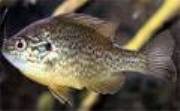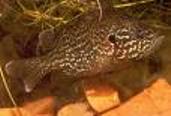Adaptations
The pumpkinseed sunfish had adapted in many ways to the surroundings that it lives in. It's skin reflects the perfect camouflage for it's area. The pattern that seems to appear on the pumpkinseed resembles that of the sunlight patterns that reflect on the bay and river beds. This pattern also allows them to be camouflaged within the vegetation that they reside in.
For defense, the pumpkinseed sunfish has developed a specific method of protection. Along the dorsal fin, there are ten to eleven spines, and three on the anal fin. All of these are very sharp which help against predation. An adaptation that the Pumpkinseed has is to anticipate approaching predators (or prey) is the ability to detect changes or movements in the water using different mechanical receptors.
The bright colored gills also serve as a method of protection and dominance. When a pumpkinseed feels threatened by predators, the Pumpkinseed will flare their gills to make them seem larger in size, but also to emphasis the red coloration.
Because the populations of pumpkinseed sunfish have increased
over the years and the areas in which they can be found
 has
spread out so far, the species itself has undergone adaptations.
One reason for the changes in population densities is the
availability of the sources in the pumpkinseed's habitat. As the numbers have increased, the sizes of the individual fish
have decreased. This can have both positive and negative
effects for the fish. Because they are smaller, they're ability
to intimidate each other predators decreases. But because they
are smaller, they gain the ability to hide in smaller places.
Also as population sizes increase, individuals mature much
earlier. Studies show that with high density populations,
individuals mature later and have delayed reproduction and
reproduction efforts.
has
spread out so far, the species itself has undergone adaptations.
One reason for the changes in population densities is the
availability of the sources in the pumpkinseed's habitat. As the numbers have increased, the sizes of the individual fish
have decreased. This can have both positive and negative
effects for the fish. Because they are smaller, they're ability
to intimidate each other predators decreases. But because they
are smaller, they gain the ability to hide in smaller places.
Also as population sizes increase, individuals mature much
earlier. Studies show that with high density populations,
individuals mature later and have delayed reproduction and
reproduction efforts.
Back to home page: Web page
